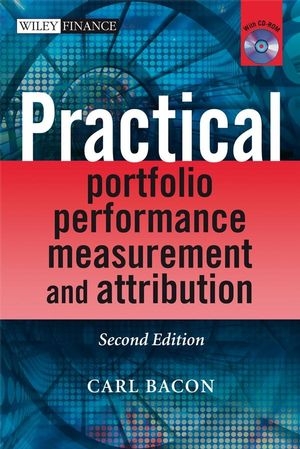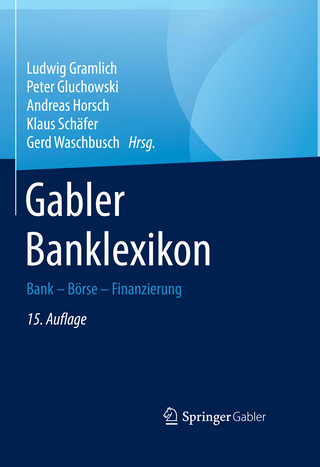
Practical Portfolio Performance Measurement and Attribution
John Wiley & Sons Inc
978-0-470-05928-9 (ISBN)
- Titel erscheint in neuer Auflage
- Artikel merken
Performance measurement and attribution are key tools in informing investment decisions and strategies. Performance measurement is the quality control of the investment decision process, enabling money managers to calculate return, understand the behaviour of a portfolio of assets, communicate with clients and determine how performance can be improved.
Focusing on the practical use and calculation of performance returns rather than the academic background, Practical Portfolio Performance Measurement and Attribution provides a clear guide to the role and implications of these methods in today's financial environment, enabling readers to apply their knowledge with immediate effect.
Fully updated from the first edition, this book covers key new developments such as fixed income attribution, attribution of derivative instruments and alternative investment strategies, leverage and short positions, risk-adjusted performance measures for hedge funds plus updates on presentation standards. The book covers the mathematical aspects of the topic in an accessible and practical way, making this book an essential reference for anyone involved in asset management.
About the author CARL BACON CIPM, is Chairman of StatPro, a data and software development specialist providing services for the asset management industry. He also runs his own consultancy business providing advice to asset managers on various risk and performance measurement issues. Prior to joining StatPro, Carl was Director of Risk Control and Performance at Foreign & Colonial Management Ltd., Vice President Head of Performance (Europe) for J P Morgan Investment Management Inc., and Head of Performance for Royal Insurance Asset Management. Carl holds a B.Sc. Hons. in Mathematics from Manchester University, is an executive committee member of Investment-Performance.com and also an associate tutor for 7city Learning. A founder member of both the Investment Performance Council and GIPS®, Carl is ex-chair of the IPC Interpretations & IPC Verification Sub-Committees, and is a member of the Advisory Board of the Journal of Performance Measurement. Author of the first edition of Practical Portfolio Performance Measurement & Attribution published in 2004 as part of the Wiley Finance SeriesCarl is also Editor of Advanced Portfolio Attribution Analysis.
Acknowledgements xv
1 Introduction 1
Why measure portfolio performance? 1
The performance measurement process 2
The purpose of this book 2
Role of performance measurers 2
Book structure 3
2 The Mathematics of Portfolio Return 5
Simple return 5
Money-weighted returns 7
Internal rate of return (IRR) 7
Simple internal rate of return 7
Modified internal rate of return 8
Simple Dietz 10
ICAA method 11
Modified Dietz 12
Time-weighted returns 13
True time-weighted 13
Unit price method 14
Time-weighted versus money-weighted rates of return 16
Approximations to the time-weighted return 18
Index substitution 18
Regression method (or β method) 19
Analyst’s test 19
Hybrid methodologies 20
Linked modified Dietz 21
BAI method (or linked IRR) 21
Which method to use? 21
Self-selection 22
Annualised returns 27
Return hiatus 28
Continuously compounded returns 28
Gross- and net-of-fee calculations 29
Estimating gross- and net-of-fee returns 30
Initial fees 32
Portfolio component returns 32
Component weight 32
Short positions 34
Overlay strategies 34
Carve-outs 34
Multi-period component returns 35
Base currency and local returns 35
3 Benchmarks 39
Benchmarks 39
Benchmark attributes 39
Commercial indexes 39
Calculation methodologies 40
Aggregate price index (price-weighted index) 40
Geometric (or Jevons-type) index 41
Market capitalisation index 41
Laspeyres index 41
Paasche index 42
Marshall–edgeworth index 42
Fisher index 42
Equal-weighted indexes 42
Fundamental indexes 43
Currency effects in benchmark 43
Hedged indexes 43
Customised (or composite) indexes 44
Fixed weight and dynamised benchmarks 45
Capped indexes 45
Blended (or spliced) indexes 46
Money-weighted benchmarks 47
Benchmark statistics 47
Index turnover 47
Up capture indicator 47
Down capture indicator 47
Up number ratio 48
Down number ratio 48
Up percentage ratio 48
Down percentage ratio 48
Percentage gain ratio 48
Peer groups and universes 48
Percentile rank 49
Random portfolios 50
Notional funds 50
Normal portfolio 51
Growth and value 51
Excess return 51
Arithmetic excess return 51
Geometric excess return 52
Performance fees 55
Symmetrical performance fees (or fulcrum fees) 55
Asymmetrical performance fees 56
Performance fee structures 57
Sliding scale 57
Performance fee caps 57
Hurdle rate 58
Crystallisation 58
High water mark 58
Equalisation 58
4 Risk 61
Definition of risk 61
Risk management versus risk control 61
Risk aversion 62
Risk measures 62
Ex post and ex ante 62
Variability 62
Mean absolute deviation 62
Variance 63
Standard deviation 63
Frequency and number of data points 64
Sharpe ratio (reward to variability) 64
Risk-adjusted return: M2 67
M2 excess return 68
Differential return 68
GH1 (Graham and Harvey 1) 69
GH2 (Graham and Harvey 2) 70
Regression analysis 70
Regression equation 71
Regression alpha (αR ) 71
Regression beta (βR ) 71
Regression epsilon (εR ) 71
Capital asset pricing model (CAPM) 72
Beta (β) (systematic risk or volatility) 72
Jensen’s alpha (or Jensen’s measure or Jensen’s differential return or ex post alpha) 72
Bull beta (β+) 72
Bear beta (β−) 73
Beta timing ratio 73
Covariance 73
Correlation (ρ) 73
Correlation and risk-adjusted return: M3 74
R2 (or coefficient of determination) 75
Systematic risk 75
Specific or residual risk 75
Treynor ratio (reward to volatility) 75
Modified Treynor ratio 77
Appraisal ratio (or Treynor–Black ratio) 77
Modified Jensen 77
Fama decomposition 77
Selectivity 78
Diversification 78
Net selectivity 78
Relative risk 78
Tracking error 78
Information ratio 80
Return distributions 81
Normal (or Gaussian) distribution 81
The central limit theorem 81
Skewness (Fisher’s or moment skewness) 83
Sample skewness 84
Kurtosis (Pearson’s kurtosis) 84
Sample kurtosis 84
Bera–Jarque statistic 85
Risk-adjusted performance measures for hedge funds 85
Drawdown 87
Average drawdown 87
Maximum drawdown 87
Largest individual drawdown 87
Recovery time (or drawdown duration) 87
Drawdown deviation 88
Ulcer index 88
Pain index 89
Calmar ratio 89
Sterling ratio 89
Sterling–Calmar ratio 90
Burke ratio 90
Modified Burke ratio 91
Martin ratio (or ulcer performance index) 91
Pain ratio 91
Lake ratio 91
Peak ratio 92
Downside risk (or semi-standard deviation) 92
Upside risk 92
Shortfall risk (or downside frequency) 94
Omega ratio (Ω) 94
Bernardo and Ledoit (or gain–loss) ratio 95
d ratio 95
Omega–Sharpe ratio 95
Sortino ratio 96
Kappa (κl ) 96
Upside potential ratio 97
Volatility skewness 97
Variability skewness 98
Adjusted Sharpe ratio 99
Skewness–kurtosis ratio 99
Prospect ratio 100
Value at risk (VaR) 100
Variance–covariance (or parametric) 100
Historical simulation (or non-parametric) 100
Monte Carlo simulation 101
VaR ratio 101
Reward to VaR ratio 101
Conditional VaR (or expected shortfall) 101
Conditional Sharpe ratio 101
Modified VaR 102
Modified Sharpe ratio 102
Return adjusted for downside risk 102
M2 for Sortino 102
Omega excess return 103
Hurst index 104
Fixed Income Risk 104
Duration (or volatility) 104
Macaulay duration 104
Modified duration 105
Macaulay–Weil duration 105
Portfolio duration 105
Effective duration (or option-adjusted duration) 107
Duration to worst 107
Convexity 108
Modified convexity 108
Effective convexity 108
Duration beta 108
Reward to duration 108
Which risk measures to use? 108
Risk efficiency ratio 109
Fund rating systems 109
Risk control structure 114
5 Performance Attribution 117
Arithmetic attribution 117
Brinson, Hood and Beebower 118
Asset allocation 118
Security (or stock) selection 119
Interaction 120
Brinson and Fachler 125
Interaction 126
Geometric excess return attribution 129
Asset allocation 130
Stock selection 130
Sector weights 133
6 Multi-currency Attribution 135
Ankrim and Hensel 135
Karnosky and Singer 140
Geometric multi-currency attribution 146
Naive currency attribution 146
Compounding effects 148
Geometric currency allocation 153
Currency timing 154
Interest rate differentials 155
Revised currency allocation 160
Revised country allocation 161
Incorporating forward currency contracts 163
Other currency issues 170
7 Fixed Income Attribution 171
The yield curve 171
Yield to maturity (or gross redemption yield) 171
Coupon yield curve 171
Par yield curve 171
Zero-coupon (or spot) curve 172
Wagner and Tito 172
Weighted duration attribution 173
Geometric fixed income attribution 178
Campisi framework 181
Yield curve analysis 187
Shift 187
Twist (or slope) 188
Curvature (or butterfly) 188
Carry 188
Credit (or spread) 189
Yield curve decomposition 189
8 Multi-period Attribution 191
Smoothing algorithms 191
Carino 191
Menchero 194
GRAP method 196
Frongello 199
Davies and Laker 201
Multi-period geometric attribution 204
Annualisation of excess return 206
Attribution annualisation 207
9 Further Attribution Issues 209
Attribution variations 209
Contribution analysis (or absolute return attribution) 209
Return (or regression)-based attribution 209
Holding-based (or buy/hold) attribution 209
Transaction-based attribution 210
Security-level attribution 210
Transaction costs 212
Off-benchmark (or zero-weight sector) attribution 213
Multi-level attribution 215
Balanced attribution 221
Lookthrough attribution (or fund of funds attribution) 221
Attribution standards 221
Evolution of performance attribution methodologies 222
Risk-adjusted attribution 223
Selectivity 224
10 Performance Measurement for Derivatives 227
Futures 227
Equity index future 227
Libor (London interbank offered rate) 228
Attribution including equity index futures 228
Leverage (or gearing) 232
Forward foreign exchange (FFX) contract (or currency forward) 235
Swaps 235
Interest rate swaps 236
Total return swap 236
Credit default swap 236
Equity index swaps 236
Contracts for difference (CFD) 237
Options 237
Option price sensitivity (the Greeks) 238
Warrants 239
Convertible bonds 239
Attribution analysis using options, warrants and convertible bonds 240
Market neutral attribution 241
Attribution for 130/30 funds (or extended short funds) 243
11 Performance Presentation Standards 247
Why do we need performance presentation standards? 247
Global Investment Performance Standards (GIPS®)248
Advantages for asset managers 248
The standards 250
Composites 250
Presentation 251
Calculation 251
Claim of compliance 252
Structure of the standards 252
Verification 253
Verification/practitioners subcommittee 254
Interpretations subcommittee 254
Guidance statements 254
Definition of firm 255
Carve-outs 255
Significant cash flows 256
Portability 256
Supplemental information 257
Error correction 257
Measures of dispersion 258
Equal-weighted standard deviation 258
Asset-weighted dispersion 258
High–low 258
Interquartile range 258
Achieving compliance 259
Maintaining compliance 259
Appendix A Simple Attribution 261
Appendix B Multi-currency Attribution Methodology 264
Appendix C EIPC Guidance for Users of Attribution Analysis 271
Appendix D European Investment Performance Committee – Guidance on Performance Attribution Presentation 275
Appendix E The Global Investment Performance Standards 287
Appendix F Guidance Statement on Composite Definition 324
Appendix G Sample Global Investment Performance Standards Presentation 334
Appendix H Calculation Methodology Guidance Statement 336
Appendix I Definition of Firm Guidance Statements 345
Appendix J Treatment of Carve-outs Guidance Statement 351
Appendix K Significant Cash Flow Guidance Statement 356
Appendix L Guidance Statement on Performance Record Portability 361
Appendix M Guidance Statement on the Use of Supplemental Information 365
Appendix N Guidance Statement on Recordkeeping Requirements of the GIPS Standards 369
Appendix O Useful Websites 376
Bibliography 377
Index 381
| Erscheint lt. Verlag | 1.7.2008 |
|---|---|
| Reihe/Serie | Wiley Finance Series |
| Verlagsort | New York |
| Sprache | englisch |
| Maße | 177 x 252 mm |
| Gewicht | 844 g |
| Themenwelt | Wirtschaft ► Betriebswirtschaft / Management ► Finanzierung |
| Schlagworte | Performancemessung (Wirtschaft) • Portfolio-Management |
| ISBN-10 | 0-470-05928-1 / 0470059281 |
| ISBN-13 | 978-0-470-05928-9 / 9780470059289 |
| Zustand | Neuware |
| Haben Sie eine Frage zum Produkt? |
aus dem Bereich



